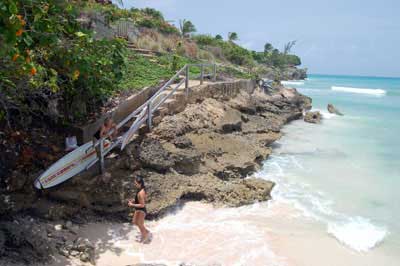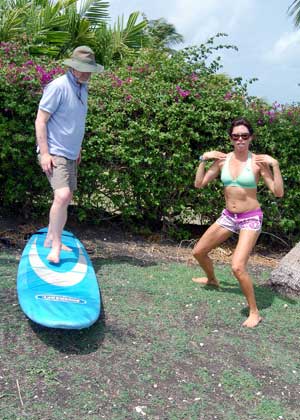By Stephen Brookes • The Washington Post • January 4, 2009
If you need someone to dominate the power of the oceans, I'm the wrong person to call. Those surfers who glide effortlessly down 12-foot tsunamis, rippling their muscles and getting tanner with every passing wave? That's not me. I'm the pale, lazy guy sitting back on the beach -- the one under the umbrella with a book, a cooler and a lifetime supply of SPF 100.
 Freights Bay, BarbadosSo what was I doing this brilliant July morning, standing on a cliff in Barbados with a surfboard under my arm? Down below, the surf was crashing into the rocks with a menacing roar. By my side, five other surfing novices, from their early 20s to somewhere in their 50s, were huddled around our instructor, Melanie Pitcher, and we were listening closely. She was teaching us how not to get killed.
Freights Bay, BarbadosSo what was I doing this brilliant July morning, standing on a cliff in Barbados with a surfboard under my arm? Down below, the surf was crashing into the rocks with a menacing roar. By my side, five other surfing novices, from their early 20s to somewhere in their 50s, were huddled around our instructor, Melanie Pitcher, and we were listening closely. She was teaching us how not to get killed.
"The surfboard is the most dangerous thing out there," said Melanie, waving at the surging Atlantic. "Just don't be on the wrong side of the surfboard when a wave crashes on you, or you'll get nailed. And try not to jump onto any sharp coral. You probably won't remember any of this when you're out there, but don't worry about it. It's going to be fun!"
We looked at one another nervously. I'd signed up for this class at the last minute, on one of those middle-aged "things you must do before you die" impulses. I knew I'd never be hanging 10 in Malibu or riding the Banzai Pipeline in Oahu, but I didn't care. All I wanted was to get upright, yell "Cowabunga!" and then go home to impress my children with my awesome surfer-dude coolness.
And Barbados seemed as good a place as any to get started. It's still well off the beaten path, but with some of the best and most consistent waves in the Caribbean, it's becoming a magnet for serious surfers. And there are some spectacular surf spots, such as the legendary Soup Bowl on the island's rugged east coast, which, frankly, is scary just to look at.
But we were down at the "beginners" beach, Freights Bay, at the southern end of the island, where the waves are gentle and no one really expects much of you. On a grassy bluff overlooking the water, Melanie walked us through Surfing 101, which is basically just paddling on your stomach, then getting upright on the board into proper surfing position.
 Goofy foot and Melanie, safe on dry landIt turns out there are two ways to do this. You can (a) push up off the board with your toes, leaping with feline agility into a perfectly balanced pose; or (b) clamber your way clumsily upright, flailing your arms and hoping for the best.
Goofy foot and Melanie, safe on dry landIt turns out there are two ways to do this. You can (a) push up off the board with your toes, leaping with feline agility into a perfectly balanced pose; or (b) clamber your way clumsily upright, flailing your arms and hoping for the best.
Melanie demonstrated the first method. It looked easy. The 20-somethings tried it, and all floated into position as if they'd grown up in Malibu.
Then the rest of us gave it a shot.
"Oh, look!" said Melanie, after I'd taken a minute to lumber into a wobbly, semi-vertical pose. "You're a Goofy foot!"
I looked at her, stricken. "Don't worry," she said. "It's just a term for people who put their right foot forward on the board, rather than their left." I nodded, but still . . . Goofy foot? That couldn't be good.
But there wasn't time to be humiliated. The surf was up (as we surfers say), so we climbed down to a narrow strip of beach where Melanie launched us into the ocean one by one, like little ducklings. We paddled out past the breaking waves and practiced sitting on our boards, bobbing happily as the swells, no more than a few feet high, lifted us up and down.
So far, as midlife adventures go, this one was working out pretty well. Is there anything that embodies carefree youth more than surfing, with its easy, endless summers and melanoma-free tans? I may have been a few decades late to the party, but here I finally was. The sun was golden, the waves were warm and green, there were girls in bikinis and once in a while a gigantic sea turtle would swim by. It was surfing as imagined by Walt Disney. I could have bobbed there all day.
Then, of course, it all had to end.
"Okay, who's ready?" shouted Melanie, and I paddled over. She grabbed my board, and, with one eye on the incoming waves, gave me a final piece of advice. "Don't forget to . . . " she started to shout, but a wave had caught the board and I was off in a wild rush. Paddling madly, I picked up speed and somehow pushed myself forward on the board, my feet a confused tangle, my arms pinwheeling in the air.
And suddenly, for one brief glorious moment, I was up.
And just as suddenly, down again, the board crashing around my ears in the foaming water. But the feeling was incredible. I'd been vertical for only a nanosecond or two, but it didn't matter. Goofy-footed or not, I had surfed. Some hole in my life that I didn't even know was there had been filled -- filled, I might add, with awesome surfer-dude coolness. It felt good.
And now I can go back to my umbrella.
•••••
GETTING THERE: American and US Airways offer convenient flight schedules from Reagan National to Bridgetown, Barbados; price starts at about $560 round trip. American also offers good connections from BWI; price starts at about $600 round trip. An additional baggage fee is sometimes charged for surfboards; check with the airlines for details.
WHEN TO GO: Serious surfers go between October and March, when there are usually two- to 12-foot waves in the northern part of the island, and up to six feet on the other beaches. Summer visitors get the advantage of near-empty beaches as well as the annual Crop Over Festival, the island's biggest (and most boisterous) cultural event.
WHERE TO SURF: The coral reefs that surround Barbados and the constant trade winds create a variety of surfing conditions, from the mild waves of the west coast to the more dramatic surf of the east. The most challenging spot is the Soup Bowl in the beach town of Bathsheba. Other east coast spots for the experienced surfer include Barclays Park, North Point and Parlor. Newbies may want to start at the gentler beaches in the south, particularly Freights Bay, Brandon Beach, Accra Beach and South Point. Melanie Pitcher of Barbados Surf Trips (246 262-1099; http://www.surfbarbados.com) designs surfing vacations for all levels and can arrange lodging and transportation. Packages start at $425 a week.
WHERE TO STAY: Accommodations are scarce in the agreeably laid-back town of Bathsheba, but try the New Edgewater Hotel (866 978-5067, http://www.newedgewater.com), where winter rates, Dec. 15-April 14, are $116 to $212 per night. Most of the better hotels are on the island's west coast. Big spenders flock to the Sandy Lane Hotel (St. James Parish, 246 444-2000, http://www.sandylane.com), where rooms start at $1,000 a night in summer. But we had a wonderful stay at the Crane (St. Philip Parish, 246 423-6220, http://www.thecrane.com), a historic hotel on a spectacular bluff on the southeast coast. Winter rates start at $210, and it's close to all the surfing spots. Farther south, the Little Arches Hotel (Christchurch Parish, 246 420-4689, http://www.littlearches.com) is a charming and popular boutique hotel, where winter rates start at $245.
WHERE TO EAT: No trip is complete without the Friday-night fish fry at Oistin's Bay on the south coast. You grab a picnic table and order fresh grilled fish from one of the dozens of small open-air restaurants there. It's noisy, crowded and fun. Try the flying fish. If you're looking for upscale dining, though, try The Tides (Holetown, http://www.tidesbarbados.com) or The Cliff (St. James Parish, http://www.thecliffbarbados.com), which is pricey but famous for its cuisine. Or check out Thai and Japanese food at Zen (in the Crane Hotel), which features giggling Barbados waitresses in kimonos.